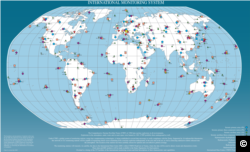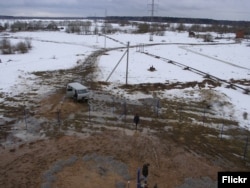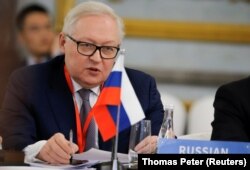Following reports of an explosion that occurred at a military facility near Severodvinsk in Russia’s Arkhangelsk region on August 8, 2019, the two Russian radionuclide monitoring stations closest to the blast (Kirov and Dubna) reportedly went offline on August 10.
On August 20, the Kremlin’s spokesman said, that a “nuclear-propelled missile was being tested,” fueling the reports that the Russian Defense Ministry was conducting a test of the nuclear-powered Burevestnik/SSC-X-9 “Skyfall” cruise missile when the explosion occurred.
According to Rosatom, the Russian state corporation that specializes in nuclear energy, five people were killed in a blast. The independent Novaya Gazeta reported on Wednesday, two specialists died not of traumatic injuries from the blast itself but of radiation sickness.
Lassina Zerbo, Executive Secretary of the Comprehensive Nuclear-Test-Ban Treaty Organization – designed to detect any nuclear explosion conducted on Earth – tweeted the CTBTO was addressing those technical problems with station operators in Russia.
Zerbo tweeted out an animated map of a “potential plume” showing the possible movement of radionuclides that would have been detected by those two monitoring stations.
The CTBTO would later clarify that image was “standard tech modeling and did “not show actual [radionuclide] detection and is not health-related.”
Two other radionuclide-monitoring stations in Siberia also reportedly stopped transmitting data on August 13, although they later came back online.
"RN stations RUP 56 (Peleduy) and RUP 57 (Bilibino) have resumed operations in Russia & are currently backfilling data," Zerbo tweeted.
Speaking to reporters on August 20, Russian Presidential Spokesman Dmitry Peskov said the Kremlin is not responsible for monitoring those stations.
“As for the work of the [radiation monitoring] stations, I honestly don’t know who they are subordinate to. It’s probably up to you to find out who they belong to and ask for information why this or that information is either transmitted or not transmitted,” Peskov said.
So who do those stations belong to?
The CTBTO’s International Monitoring System (IMS), when fully functioning, consists of 337 facilities located worldwide, with Radionuclide stations being among the four monitoring technologies employed.
The CTBTO said while information gathered from those stations is sent back to its office in Vienna, Austria, local institutions control those facilities. Through the CTBTO’s International Data Center, all raw data and data bulletins generated by the 300-plus facilities at its disposal are accessible to all state signatories of the Comprehensive Nuclear-Test-Ban Treaty. This information “can assist a state in exercising its prerogative to make the final judgement in the case of a suspicious event.”
According to the CTBTO, the Russian portion of the CTBT’s International Monitoring System covers 32 facilities, including six primary and 13 auxiliary seismic stations, four infrasound stations, eight radionuclide stations and one radionuclide laboratory. Apart from the radionuclide monitoring station, Dubna also hosts an infrared sound station, a noble gas system and the National Data Center (NDC).
The CTBTO said NDCs are usually “institutions specializing in verification technologies, such as a national earthquake institution or a nuclear radiation monitoring agency.”
In Russia, the body responsible for handling the country’s segment of the CTBTO is the 12th Chief Directorate of the Russian Ministry of Defense.
As the Supreme Commander-in-Chief of the Armed Forces of the Russian Federation, the Ministry of Defense is under Putin’s auspices.
That critical aspects of Russia’s own monitoring system would go down at a time when Russian President Vladimir Putin has denied an increase in background radiation following a mysterious explosion has fueled speculation Russian authorities intentionally took the stations offline.
Does that make the Kremlin responsible for the radionuclide monitoring stations? Constitutionally – yes, from the technical perspective, however, experts’ opinions differ.
Daryl G. Kimball, Executive Director of the Arms Control Association, a U.S. based non-partisan organization promoting arms control, said individual human beings at their respective institutions are ultimately monitoring that data.
Although the Russian government is ultimately responsible for operating the stations even if the data is sent onto the CBTBO, Kimball told Polygraph.info it would be a “a big stretch” to say the Kremlin is directly in charge of them.
Kimbal said Peskov “should know” who the stations are subordinate to, but added press secretaries don’t always have the facts “immediately at their disposal.”
Russia’s Interfax news agency said the Russian Ministry of Defense has so far not answered questions regarding its failure to transmit data to the CTBTO monitoring system.
Deputy Foreign Minister Sergei Ryabkov told Interfax that the transfer of data from stations of the national segment to the international monitoring system of any country is “purely voluntary."
That, according to the CTBTO, is correct. While monitoring data is central to the CTBTO’s verification efforts, member states’ data belongs to them.
“What is absurd is why Russian government won’t explain why these stations went down,” Kimbal told Polygraph.info. “They didn’t want the info these stations can provide to be known.”
As for Peskov’s statement,, while the radiation detection facilities might technically be under the Ministry of Defense, Polygraph.info finds his claim that the Kremlin is not responsible for them to be misleading.









